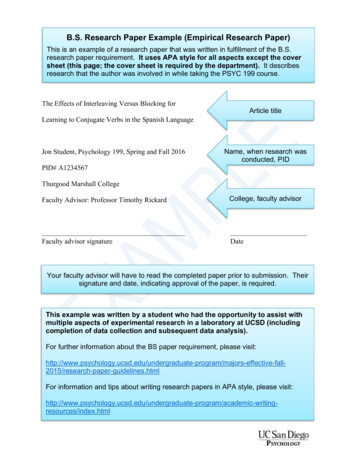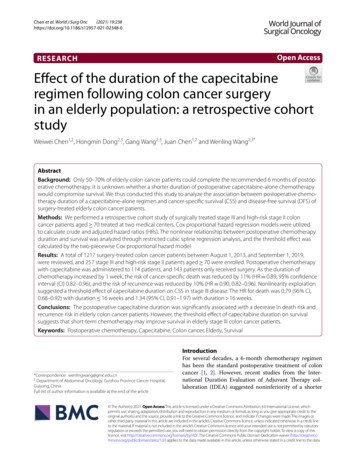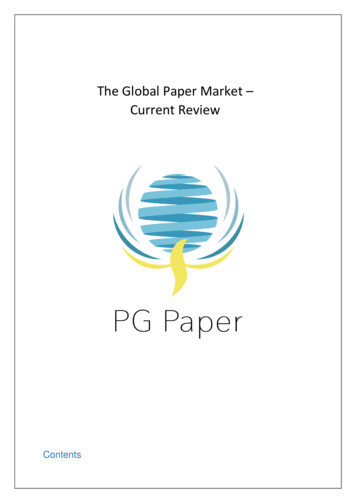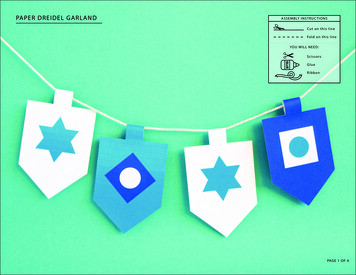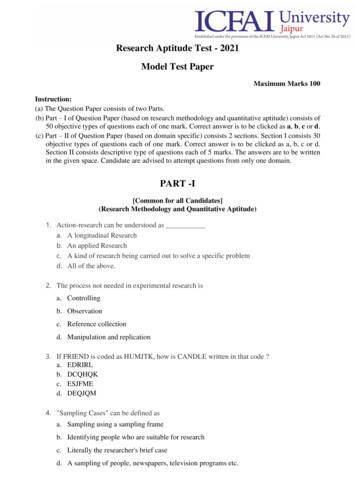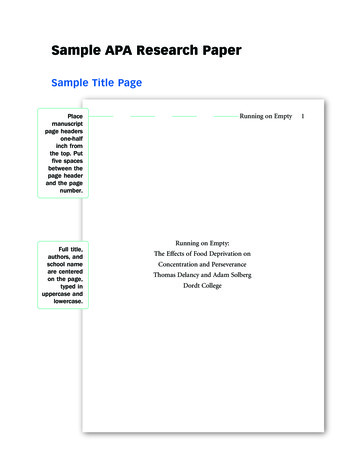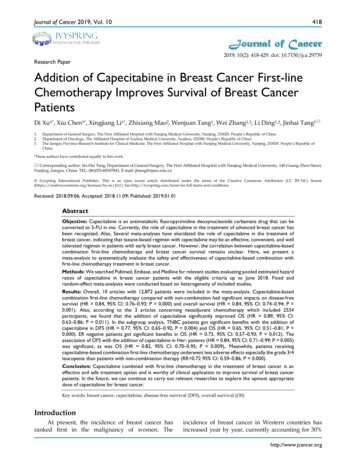
Transcription
Journal of Cancer 2019, Vol. 10IvyspringInternational PublisherResearch Paper418Journal of Cancer2019; 10(2): 418-429. doi: 10.7150/jca.29739Addition of Capecitabine in Breast Cancer First-lineChemotherapy Improves Survival of Breast CancerPatientsDi Xu1*, Xiu Chen1*, Xingjiang Li1*, Zhixiang Mao2, Wenjuan Tang1, Wei Zhang1,3, Li Ding1,3, Jinhai Tang1 1.2.3.Department of General Surgery, The First Affiliated Hospital with Nanjing Medical University, Nanjing, 210029, People’s Republic of ChinaDepartment of Oncology, The Affiliated Hospital of Xuzhou Medical University, Xuzhou, 221000, People’s Republic of ChinaThe Jiangsu Province Research Institute for Clinical Medicine, The First Affiliated Hospital with Nanjing Medical University, Nanjing, 210029, People’s Republic ofChina*These authors have contributed equally to this work. Corresponding author: Jin-Hai Tang, Department of General Surgery, The First Affiliated Hospital with Nanjing Medical University, 140 Guang-Zhou Street,Nanjing, Jiangsu, China. TEL: (86)025-68307843, E-mail: jhtang@njmu.edu.cn Ivyspring International Publisher. This is an open access article distributed under the terms of the Creative Commons Attribution (CC BY-NC) /4.0/). See http://ivyspring.com/terms for full terms and conditions.Received: 2018.09.06; Accepted: 2018.11.09; Published: 2019.01.01AbstractObjective: Capecitabine is an antimetabolic fluoropyrimidine deoxynucleoside carbamate drug that can beconverted to 5-FU in vivo. Currently, the role of capecitabine in the treatment of advanced breast cancer hasbeen recognized. Also, Several meta-analyses have elucidated the role of capecitabine in the treatment ofbreast cancer, indicating that taxane-based regimen with capecitabine may be an effective, convenient, and welltolerated regimen in patients with early breast cancer. However, the correlation between capecitabine-basedcombination first-line chemotherapy and breast cancer survival remains unclear. Here, we present ameta-analysis to systematically evaluate the safety and effectiveness of capecitabine-based combination withfirst-line chemotherapy treatment in breast cancer.Methods: We searched Pubmed, Embase, and Medline for relevant studies evaluating pooled estimated hazardratios of capecitabine in breast cancer patients with the eligible criteria up to June 2018. Fixed andrandom-effect meta-analyses were conducted based on heterogeneity of included studies.Results: Overall, 10 articles with 12,872 patients were included in the meta-analysis. Capecitabine-basedcombination first-line chemotherapy compared with non-combination had significant impacts on disease-freesurvival (HR 0.84, 95% CI: 0.76–0.93; P 0.000) and overall survival (HR 0.84, 95% CI: 0.74–0.94; P 0.001). Also, according to the 3 articles concerning neoadjuvant chemotherapy which included 2534participants, we found that the addition of capecitabine significantly improved OS (HR 0.89, 95% CI:0.63–0.86; P 0.011). In the subgroup analysis, TNBC patients got significant benefits with the addition ofcapecitabine in DFS (HR 0.77, 95% CI: 0.65–0.92; P 0.004) and OS (HR 0.65, 95% CI: 0.51–0.81; P 0.000). ER negative patients got significant benefits in OS (HR 0.73, 95% CI: 0.57–0.93; P 0.012). Theassociation of DFS with the addition of capecitabine in Her- patients (HR 0.84, 95% CI: 0.71–0.99; P 0.005)was significant, as was OS (HR 0.82, 95% CI: 0.70–0.95; P 0.009),. Meanwhile, patients receivingcapecitabine-based combination first-line chemotherapy underwent less adverse effects especially the grade 3/4leucopenia than patients with non-combination therapy (RR 0.72 95% CI: 0.59–0.86; P 0.000).Conclusion: Capecitabine combined with first-line chemotherapy in the treatment of breast cancer is aneffective and safe treatment option and is worthy of clinical application to improve survival of breast cancerpatients. In the future, we can continue to carry out relevant researches to explore the upmost appropriatedose of capecitabine for breast cancer.Key words: breast cancer, capecitabine, disease-free survival (DFS), overall survival (OS)IntroductionAt present, the incidence of breast cancer hasranked first in the malignancy of women. Theincidence of breast cancer in Western countries hasincreased year by year, currently accounting for 30%http://www.jcancer.org
Journal of Cancer 2019, Vol. 10of all new female tumors [1]. Now, the treatment ofbreast cancer has entered an era of the comprehensivetreatment, and it has formed a mode of treatment thatemphasizes both local treatments and systemictreatments of breast cancer. With the development ofthe systemic adjuvant chemotherapy, the survivaloutcome of breast cancer patients has beensignificantly improved.The international guide with constant updateslately suggests that for breast cancer treatment,anthracycline plus cyclophosphamide, followed bytaxane (AC-T), epirubicin plus cyclophosphamide,followed by paclitaxel (EC-P), docetaxel plus doxorubicin and cyclophosphamide (TAC), AC, EC, TC arerecommended as the first-line chemotherapy regimen.Besides, among the neoadjuvant chemotherapyregimens, we usually chose programs including bothanthracyclines (A) and taxanes (C) according to thelatest guide.Capecitabine, also known as Xeloda, is anantimetabolic fluoropyrimidine deoxynucleosidecarbamate drug that can be finally converted to5-fluorouracil (5-FU) in vivo by thymidine phosphorylase (dThdPase) which can concentrate more intumour tissues than in normal tissues [2].Capecitabine has been proven effective as an adjuvanttreatment in the metastatic or advanced breast cancer.Namely, it can be used as a rescue treatment [3,4]. Itcan be used alone or in combination with multipledrugs [5,6]. Also, several meta-analyses haveelucidated the role of capecitabine in the treatment ofbreast cancer. One indicated that taxane-basedregimen with capecitabine may be an effective,convenient, and well tolerated regimen in patientswith early breast cancer [7]. Another meta-analysisindicated that neoadjuvant chemotherapy involvingcapecitabine can’t significantly improve outcomes inbreast cancer patients without distant metastasis [8].However, if the addition of capecitabine in breastcancer first-line chemotherapy can improve thesurvival of breast cancer patients hasn’t beenconvinced.Recently, many phase III clinical trials have beenundertaken to evaluate the efficacy of capecitabinecombined with first-line chemotherapy. In the studyof Minckwitz in 2013, it suggested that disease-freesurvival (DFS) was longer in early non-respondersreceiving TAC-NX than in those receiving TAC, but itdid not significantly improve overall survival (OS) [9].The trial of Joyce in 2015 found that AC-TX regimensignificantly improved the OS rather than DFS [10].So, we present this meta-analysis to apecitabine-based combination first-line chemotherapy in breast cancer patients. We defined the419outcomes of DFS and OS as the main endpoints in ourmeta-analysis. Also, we performed a subgroupanalysis such as neoadjuvant and adjuvant chemotherapy results, hormone receptor (ER) and humanepidermal growth factor receptor 2 (HER2) status andsafety.Materials and MethodsSearch StrategyThe following databases were searched forrelevant studies: Pubmed (from 1996 to April, 2018),Embase(from 1947 to April, 2016), and Medline, andCochrane Central Register of Controlled Trials(CENTRAL, from 2000 to April, 2016). We use thefollowing keywords for search: ‘‘capecitabine’’ or‘‘Xeloda’’ and the expanded MeSH term ‘‘BreastNeoplasms’’ “breast cancer”. We restricted thelanguage of literature to English.Inclusion criteriaIn our meta-analysis, studies should meet thefollowing inclusion criteria to be eligible: (a) studieswith breast cancer patients; (b) Patients receivecapecitabine-based combination with first-line(neo)adjuvant treatment; (c) being a randomized,open-label, phase III clinical trial; (d) studies thatevaluated the efficacy of capecitabine in theneoadjuvant treatment; (e) the reported data ofoutcomes DFS or OS were sufficient to calculate; (f)reporting hazard risk [HR] with a 95% confidenceinterval [CI]. Exclusion criteria included: (a) review,meta-analysis, case report, editorial, conferenceabstract; (b) the study use single capecitabine in theadjuvant setting.Two reviewers independently selected theliteratures according to the above criteria. In case ofdisagreement, the third researcher participated in thediscussion.Data extractionData was collected in a standardized form bytwo independent reviewers. The production of formincludes author name; publication year; country;number of patients allocated to each treatment arm;follow-up time; grouping scheme of chemotherapy;clinicopathological characteristics of patients; technique used to measure the efficacy of capecitabine andthe evaluation index, etc. The evaluation index ofefficacy was disease-free survival (DFS), overallsurvival (OS). Survival data (hazard ratio [HR],confidence interval [CI] and p value) were directlytaken and used from included studies. In subgroupanalysis, we considered ER 1% as positive, and her23 or FISH as positive.http://www.jcancer.org
Journal of Cancer 2019, Vol. 10420Data analysesSurvival data were chosen as evaluation index.Fixed and random-effect meta-analyses were conducted based on heterogeneity of included studies. Datawere analyzed using descriptive statistics.ResultsCharacteristics of eligible trialsBased on the search strategy, we found a total of1667 potentially relevant articles. After screening thetitles and abstracts of these articles, 42 articles wereretrieved for detailed evaluation, other 1625 studieswere excluded because they were duplicates orirrelevant. After reading the full-text of the 42 articles,11 articles met our inclusion criteria. However, twoarticles were published at different times by the sameauthors concerning different follow-up time, so weselected the article with a longer follow-up of 10.3years. Finally, 10 articles with 12,872 patients wereincluded in the meta-analysis [9-18]. In the 10 articles,7 articles were associated with DFS and OS, 1 articlewas only associated with DFS and 2 articles was onlyassociated with OS. Flowchart of literature selectionwas presented in Figure 1. All the included articlesadopted first-line chemotherapy. Of the 12872participants,7,054receivedcapecitabinebased combination (neo)adjuvant chemotherapyregimens, and 7,018 received capecitabine-freecombination (neo)adjuvant chemotherapy regimens.The range of median follow-up was 5 to 6.2 years.Characteristics of studies are shown in Table 1.Meta-analysis of the primary endpointDisease-free survival was the primary endpoint.Fixed-effect meta-analyses were conducted based onheterogeneity of included studies (p 0.058, I2 46.8%).The HRs for DFS were reported in eight RCTs thatincluded 11,081 participants. We found that DFS wassignificantly improved in the capecitabine arm versusthe non-capecitabine arm (HR 0.84, 95% CI:0.76–0.93; P 0.000) (Figure 2). No publication biaswas found.Figure 1. Flow chart of literature selectionTable 1. Characteristics of studies12345678910AuthorMinckwitzJoyceMo busMinckwitzJoensuuN. rmanyGermanyJapanSwedenNumber of ow-up year5y6.2y5y62m59m5y10.3y5y5y5y3.5yPrimary FS,OSDFS,OSOSNeo/choNeoNeoNeoArms of the neo-FEC T,FEC T-XET,TEXDFS: Disease-free survival; OS: Overall survival; Neo: Neoadjuvant chemotherapy; cho:; E: Epirubicin; A: Adriamycin; C: Cyclophosphamide; T: Taxol; P: Paclitaxel; X:Capecitabinehttp://www.jcancer.org
Journal of Cancer 2019, Vol. 10421Figure 2. Forest plot and funnel chart of meta-analysis on the disease-free survival for the addition of capecitabine to first-line chemotherapyFigure 3. Forest plot and funnel chart of meta-analysis on the overall survival for the addition of capecitabine to first-line chemotherapyMeta-analysis of the second endpointOverall survival was the second endpoint.Fixed-effect meta-analyses were conducted based onheterogeneity of included studies (p 0.275, I2 18.3%).The HRs for OS were reported in nine RCTs thatincluded 11,372 participants. In terms of thecomparison between the capecitabine arm and thenon-capecitabine arm, there was significantdifferences in OS (HR 0.84, 95% CI: 0.74–0.94; P 0.001) (Figure 3). No publication bias was found.Subgroup analysisIn the subgroup analysis, we divided them intocapecitabine combined with adjuvant chemotherapyand capecitabine combined with neoadjuvantchemotherapy.In the 3 articles of neoadjuvant chemotherapywhich included 2534 participants, we found that thebenefit in capecitabine group was the same asnon-capecitabine group in DFS (HR 0.76, 95% CI:0.41–0.90; P 0.167) by random effect model(p 0.032,I2 70.8%) ,but it significantly improved OS (HR 0.89, 95% CI: 0.63–0.86; P 0.011) by fixed effectmodel (p 0.662, I2 0.00%) (Figure 4, 5). No publication bias was found.In addition, the rest articles were concerningabout capecitabine combined with adjuvant chemotherapy. The fixed-effect model demonstrated thatcapecitabine elicited great benefits in DFS (HR 0.88,95% CI: 0.78–0.97; P 0.011) and OS (HR 0.83, 95%CI: 0.73–0.94; P 0.002) (Figure 6, 7). No publicationbias was found.http://www.jcancer.org
Journal of Cancer 2019, Vol. 10422Figure 4. Forest plot and funnel chart of meta-analysis on the disease-free survival for neoadjuvant chemotherapyFigure 5. Forest plot and funnel chart of meta-analysis on the overall survival for neoadjuvant chemotherapyFigure 6. Forest plot and funnel chart of meta-analysis on the DFS for adjuvant chemotherapyhttp://www.jcancer.org
Journal of Cancer 2019, Vol. 10423Figure 7. Forest plot and funnel chart of meta-analysis on the OS for adjuvant chemotherapyFigure 8. Forest plot and funnel chart of meta-analysis on the disease-free survival for ER patientsAlso, we performed subgroup analysis of DFSand OS according to ER and HER2 status. We definedER 1% was positive, her2 3 or FISH was positiveand we found significant difference in this subgroup.We extracted the included literature data and foundthat 6 articles analyzed subgroup data. For the ERpositive status, no benefit was observed with theaddition of capecitabine in DFS (HR 0.85, 95% CI:0.70–1.02; P 0.073) and OS (HR 0.86, 95% CI:0.73–1.02; P 0.079) (Figure 8, 9). In ER negativepatients, the addition of capecitabine also didn’tsignificantly improve DFS (HR 0.89, 95% CI:0.77–1.02; P 0.098), however, significant benefit wasobserved in OS (HR 0.73, 95% CI: 0.57–0.93; P 0.012) (Figure 10, 11). In the subgroup according toHer2 status, the the addition of capecitabine had nosignificant benefit in Her2 patients for DFS (HR 0.86, 95% CI: 0.71–1.03; P 0.096) and OS (HR 0.86,95% CI: 0.62–1.19; P 0.359) (Figure 12, 13). Nopublication bias was found. However, In Herpatients, the association with DFS (HR 0.84, 95% CI:0.71–0.99; P 0.005) was significant, as was OS (HR 0.82, 95% CI: 0.70–0.95; P 0.009) (Figure 14, 15). Intriple negative patients, the analysis revealed thatcapecitabine improved the DFS (HR 0.77, 95% CI:0.65–0.92; P 0.004) and OS (HR 0.65, 95% CI:0.51–0.81; P 0.000) (Figure 16, 17). No publicationbias was found.Safety analysisIn all included articles, 4 articles compared safetydifferences between the capecitabine group and thenon-capecitabine group. So we analyzed 8 commonhematological and non-hematological toxicities,http://www.jcancer.org
Journal of Cancer 2019, Vol. 10including febrile neutropenia grade3/4, neutropeniagrade 3/4, leucopenia grade 3/4, thrombocytopenia,424anemia grade 3/4, diarrhea, vomiting and hand–footsyndrome.Figure 9. Forest plot and funnel chart of meta-analysis on the overall survival for ER patientsFigure 10. Forest plot and funnel chart of meta-analysis on the disease-free survival for ER- patientsFigure 11. Forest plot and funnel chart of meta-analysis on the overall survival for ER- patientshttp://www.jcancer.org
Journal of Cancer 2019, Vol. 10425Figure 12. Forest plot and funnel chart of meta-analysis on the disease-free survival for Her2 patientsFigure 13. Forest plot and funnel chart of meta-analysis on the overall survival for Her2 patientsFigure 14. Forest plot and funnel chart of meta-analysis on the disease-free survival for Her2- patientshttp://www.jcancer.org
Journal of Cancer 2019, Vol. 10426Figure 15. Forest plot and funnel chart of meta-analysis on the overall survival for Her2- patientsFigure 16. Forest plot and funnel chart of meta-analysis on the disease-free survival for TNBC patientsFigure 17. Forest plot and funnel chart of meta-analysis on the overall survival for TNBC patientsIn non-hematologic toxicity, the adverse eventdiarrhea had significant difference in cap and non-capgroup. It occured more frequently in capecitabinegroup than the non-capecitabine group (RR 2.17 95%CI: 1.10-4.69; P 0.048) (Figure 18). No publicationbias was found.In hematologic toxicity, we found that grade 3/4leucopenia was the most frequent serious adverse, itoccurred more often in non-cap group than in capgroup (RR 0.72 95% CI: 0.59–0.86; P 0.000) (Figure19). No publication bias was found.http://www.jcancer.org
Journal of Cancer 2019, Vol. 10427Figure 18. Forest plot and funnel chart of meta-analysis on the Incidence rate for diarrheaFigure 19. Forest plot and funnel chart of meta-analysis on the Incidence rate for leucopeniaThe frequency of grade 3/4 febrile neutropenia(RR 0.83 95% CI: 0.35–1.96; P 0.670), grade 3/4neutropenia (RR 0.91 95% CI: 0.55–1.50; P 0.700),thrombocytopenia (RR 0.86 95% CI: 0.02–30.17; P 0.935), vomiting (RR 0.89 95% CI: 0.61–1.30; P 0.561), anemia (RR 0.65 95% CI: 0.36–1.20; P 0.168),hand–foot syndrome (RR 10.87 95% CI: 0.03–4082.9; P 0.430) was similar in the cap and non-cap arms,respectively.Publication biasA funnel plot was applied to evaluate possiblepublication bias. Priority in positive results werereported concerning the addition of cap in the breastcancer therapies and more studies were needed toalleviate publication bias.DiscussionThe role of capecitabine in the treatment ofadvanced breast cancer has been recognized.However, it has not been confirmed that capecitabinecombined with first-line chemotherapy can improvethe survival of breast cancer patients. Ourmeta-analysis is the first to be combined with 10 phase3 clinical controlled trials to assess the efficacy ofaddition of capecitabine with first-line chemotherapyin breast cancer. Also, we conducted subgroupanalysis to compare the efficacy of capecitabine-basedversus capecitabine-free combination neoadjuvantchemotherapy and adjuvant chemotherapy. Meanwhile, there are 6 articles included in each subanalysis ofER and Her2 status, which make the study of differentsubtype patients. However, there are a limitednumber of studies included in each sub-analysis.Consequently, our meta-analysis indicates thatcapecitabine-based combination first-line chemotherapy might provide survival benefits in BCcompared with capecitabine-free regimens, theendpoint DFS and OS have significant improvements.In the past few decades, the importance ofneoadjuvant therapy for breast cancer in the treatmentof breast cancer has become increasingly clear.Clinical experts have conducted extensive research onthe choice of neoadjuvant chemotherapy regimens,and whether capecitabine is a part of the standardneoadjuvant therapy is not yet clear [19]. Ourhttp://www.jcancer.org
Journal of Cancer 2019, Vol. 10meta-analysis delivered that even in the neoadjuvantand adjuvant subgroups, the survival benefit still hassignificant improvements in DFS and OS.In a meta-analysis that evaluated the efficacyresults of capecitabine with anthracycline- andtaxane-based adjuvant therapy in early breast cancer,they pointed out that the addition of capecitabine at aHR of 0.83 (95% CI: 0.71 - 0.98) can significantlyimprove survival. Our meta-analysis find that theaddition of capecitabine can improve disease-freesurvival (HR 0.84, 95% CI: 0.76–0.93; P 0.000) andoverall survival (HR 0.84, 95% CI: 0.74–0.94; P 0.001), this is in consistent with the previousmeta-analysis [20].Also, the classification of tumors was analyzedfor the three subgroups based on ER and HER2 status.Both in the ER-group, her2- group and TNBC group,the addition of capecitabine significantly improveDFS or OS. In conclusion, the addition of capecitabinein first-line chemotherapy prolonged disease-freesurvival and overall survival in patients withER-negative or HER2-negative breast cancer. Worthemphasizing is the fact that the adjuvant capecitabinetherapy showed effectiveness among patients intriple-negative subgroup which was complicated withtreatment. However, the other two articles mentionedthe significant benefit of capecitabine group in thetriple negative subgroup by RFS, which cannot becombined with DFS [11,14].In terms of duration of treatment, the GeparQuattro study found that there was no difference inoutcome for patients receiving 24 weeks or 36 weeksof chemotherapy (P 0.818 for DFS and P 0.825) forOS [12].Capecitabine is an oral, tumor-targeted drug,which was different from intravenous medication. Inthe safety of capecitabine combination therapy, onlythe incidence of some complications will increase suchas diarrhea. The most frequent serious adverse eventwas febrile neutropenia, Grade 3 hand–footsyndrome, grade 3/4 stomatitis and grade 3/4diarrhea, which were the same as non-combinationfirst-line chemotherapy. However, the grade 3/4leucopenia occurred more often in non-cap groupthan in cap group (RR 0.72 95% CI: 0.59–0.86; P 0.000) [10-13], this may be related to the reduceddosage of docetaxel in capecitabine group [14].Above all, our meta-analysis indicates that theaddition of capecitabine in breast cancer first-linechemotherapy can significantly improve the survivalof breast cancer patients regardless of neoadjuvantand adjuvant chemotherapy. In ER-, Her2- and TNBCpatients, the addition of capecitabine will result ingreat benefits. We are looking forward to more428clinical trials to explore the most appropriate dose ofcapecitabine for breast cancer.Competing InterestsThe authors have declared that no competinginterest 15.16.17.18.19.20.Siegel R L, Miller K D, Jemal A. Cancer statistics, 2018[J]. CA: A CancerJournal for Clinicians. 2018; 60(5):277-300.Miwa M, Ura M, Nishida M, et al. Design of a novel oral fluoropyrimidinecarbamate, capecitabine, which generates 5-fluorouracil selectively intumours by enzymes concentrated in human liver and cancer tissue[J].European Journal of Cancer. 1998; 34(8):1274-81.Blum J L, Jones S E, Buzdar A U, et al. Multicenter phase II study ofcapecitabine in paclitaxel-refractory metastatic breast cancer[J]. Journal ofClinical Oncology. 1999; 17(2):485-493.Miles D, Von M G, Seidman A D. Combination versus sequentialsingle-agent therapy in metastatic breast cancer[J]. Oncologist. 2002; 7 Suppl6(Supplement 6):13-19.O'Shaughnessy J, Miles D, Vukelja S, et al. Superior survival withcapecitabine plus docetaxel combination therapy in anthracycline-pretreatedpatients with advanced breast cancer: phase III trial results[J]. Journal ofClinical Oncology. 2002; 20(12):2812-2823.Blum J L, Dieras V, Lo Russo P M, et al. Multicenter, Phase II study ofcapecitabine in taxane-pretreated metastatic breast carcinoma patients[J].Cancer. 2015; 92(7):1759-1768.Jiang Y, Yin W, Zhou L, et al. First efficacy results of capecitabine withanthracycline- and taxane-based adjuvant therapy in high-risk early breastcancer: a meta-analysis[J]. Plos One. 2012; 7(3):e32474.Li Q, Jiang Y, Wei W, et al. Clinical Efficacy of Including Capecitabine inNeoadjuvant Chemotherapy for Breast Cancer: A Systematic Review andMeta-Analysis of Randomized Controlled Trials[J]. Plos One. 2013;8(1):e53403.Von M G, Blohmer J U, Costa S D, et al. Response-guided neoadjuvantchemotherapy for breast cancer[J]. Journal of Clinical Oncology. 2013;31(29):3623.O'Shaughnessy J A, Koeppen H, Xiao Y, et al. Patients with SlowlyProliferative Early Breast Cancer have Low 5-Year Recurrence Rates in aPhase III Adjuvant Trial of Capecitabine[J]. Clinical Cancer Research AnOfficial Journal of the American Association for Cancer Research. 2015;21(19):4305.Masuda N, Lee S J, Ohtani S, et al. Adjuvant Capecitabine for Breast Cancerafter Preoperative Chemotherapy.[J]. N Engl J Med. 2017; 376(22):2147-2159.Von M G, Rezai M, Fasching P A, et al. Survival after adding capecitabineand trastuzumab to neoadjuvant anthracycline-taxane-based chemotherapyfor primary breast cancer (GBG 40--GeparQuattro)[J]. Annals of OncologyOfficial Journal of the European Society for Medical Oncology. 2014;25(1):81-9.Von M G, Möbus V, Schneeweiss A, et al. German adjuvant intergroupnode-positive study: a phase III trial to compare oral ibandronate versusobservation in patients with high-risk early breast cancer[J]. Journal ofClinical Oncology. 2013; 31(28):3531-3539.Joensuu H, Kellokumpu-Lehtinen P L, Huovinen R, et al. Adjuvantcapecitabine, docetaxel, cyclophosphamide, and epirubicin for early breastcancer: final analysis of the randomized FinXX trial[J]. Journal of ClinicalOncology. 2012; 30(1):11-18.Joensuu H, Kellokumpu-Lehtinen P L, Huovinen R, et al. AdjuvantCapecitabine in Combination With Docetaxel, Epirubicin, andCyclophosphamide for Early Breast Cancer: The Randomized Clinical FinXXTrial[J]. Jama Oncology. 2017; 3(6).Furlanetto J, Eiermann W, Marmé F, et al. Higher Rate of Severe Toxicities inObese Patients Receiving dose-dense (dd) Chemotherapy according toUnadjusted Body Surface Area- Results of the Prospectively RandomizedGAIN study[J]. Annals of Oncology Official Journal of the European Societyfor Medical Oncology. 2016; 27(11):2053.Chow L W, Nakamura S. Randomized trial of preoperative docetaxel with orwithout capecitabine after 4 cycles of 5-fluorouracil–epirubicin–cyclophosphamide (FEC) in early-stage breast cancer: exploratory analysesidentify Ki67 as a predictive biomarker for response to neoadjuvantchemotherapy. [J]. Breast Cancer Research and Treatment. 2013; 142(1):69-80.Hatschek T, Carlsson L, Einbeigi Z, et al. Individually tailored treatment withepirubicin and paclitaxel with or without capecitabine as first-linechemotherapy in metastatic breast cancer: a randomized multicenter trial.[J].Breast Cancer Research & Treatment. 2012; 131(3):939-947.Rubovszky G, Horváth Z. Recent Advances in the Neoadjuvant Treatment ofBreast Cancer.[J]. Journal of Breast Cancer. 2017; 20(2):119-131.Jiang Y, Yin W, Zhou L et al. First efficacy results of capecitabine withanthracycline- and taxane-based adjuvant therapy in high-risk early breastcancer: a meta-analysis. PLoS One. 2012; 7(3): e32474http://www.jcancer.org
Journal of Cancer 2019, Vol. 1021.429Von M G, Rezai M, Fasching P A, et al. Survival after adding capecitabineand trastuzumab to neoadjuvant anthracycline-taxane-based chemotherapyfor primary breast cancer (GBG 40--GeparQuattro)[J]. Annals of OncologyOfficial Journal of the European Society for Medical Oncology. 2014;25(1):81-9.http://www.jcancer.org
bicin and cyclophosphamide (TAC), AC, EC, TC are recommended as the first -line chemotherapy regimen. Besides, among the neoadjuvant chemotherapy regimens, we usually chose programs including both anthracyclines (A) and taxanes (C) according to the latest guide. Capecitabine, also known as Xeloda, is an antimetabolic fluoropyrimidine .

